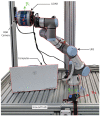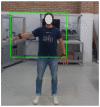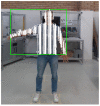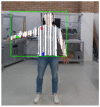Angle Assessment for Upper Limb Rehabilitation: A Novel Light Detection and Ranging (LiDAR)-Based Approach
- PMID: 38257623
- PMCID: PMC10820647
- DOI: 10.3390/s24020530
Angle Assessment for Upper Limb Rehabilitation: A Novel Light Detection and Ranging (LiDAR)-Based Approach
Abstract
The accurate measurement of joint angles during patient rehabilitation is crucial for informed decision making by physiotherapists. Presently, visual inspection stands as one of the prevalent methods for angle assessment. Although it could appear the most straightforward way to assess the angles, it presents a problem related to the high susceptibility to error in the angle estimation. In light of this, this study investigates the possibility of using a new approach to angle calculation: a hybrid approach leveraging both a camera and LiDAR technology, merging image data with point cloud information. This method employs AI-driven techniques to identify the individual and their joints, utilizing the cloud-point data for angle computation. The tests, considering different exercises with different perspectives and distances, showed a slight improvement compared to using YOLO v7 for angle calculation. However, the improvement comes with higher system costs when compared with other image-based approaches due to the necessity of equipment such as LiDAR and a loss of fluidity during the exercise performance. Therefore, the cost-benefit of the proposed approach could be questionable. Nonetheless, the results hint at a promising field for further exploration and the potential viability of using the proposed methodology.
Keywords: Artificial Intelligence; LiDAR; join angle measurement; motion capture; robotic rehabilitation.
Conflict of interest statement
The authors declare no conflicts of interest. The funders had no role in the design of the study; in the collection, analyses, or interpretation of data; in the writing of the manuscript; or in the decision to publish the results.
Figures



















References
MeSH terms
Grants and funding
LinkOut - more resources
Full Text Sources

